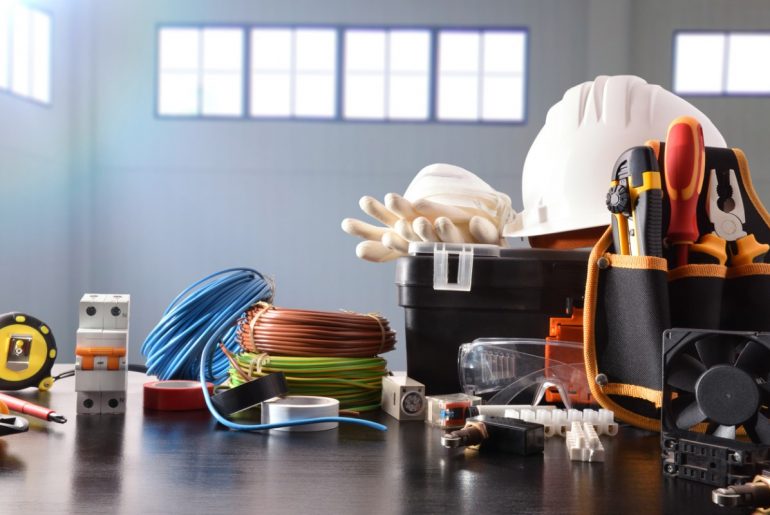Estimating electrical work blends precision with experience. As an electrical contractor, knowing how to estimate electrical work can make the difference between profit and loss. Accurately evaluating job requirements in the electrical sector is crucial, as it entails comprehending blueprints and estimating material and labor expenses.
To enhance efficiency both on-site and in the back office, modern technologies such as electrical contractor software can also be utilized. From reviewing job specifications to sending the proposal, this comprehensive guide will show you how to estimate electrical work the right way.
1. Understanding the Basics of Electrical Estimating
Accurate estimation of electrical work is crucial for the success of any electrical contractor. Understanding these basics allows contractors to provide precise and profitable job quotes, forming a solid foundation for their business.
Grasping the Fundamentals
From labor costs that hinge on the median electrician’s pay of $27.36 per hour to ensuring your estimates cover both material costs and overhead, mastery over this estimating process is crucial.
A reliable starting point often begins with establishing an hourly rate that aligns with industry standards while also factoring in your specific operational needs and profit margin goals. It’s not just about covering costs accurately—it’s about building value into every electrical job you undertake.
Importance of Accurate Estimates
A professional estimate is far more than a simple projection—it’s a promise carved out from experience and expertise within the current electrical landscape. Inaccuracies can erode trust, squeeze margins, or leave you scrambling post-completion if unforeseen expenses arise. This makes accuracy non-negotiable when preparing an electrical quote or drafting an estimation for residential projects where square-foot pricing may apply.
Your reputation as an electrical contractor hinges on how well you can forecast these figures before breaking ground—or walls—on new jobs. With resources like an updated work pricing guide, sharpening those skills becomes less guesswork and more science—a must-have capability in today’s competitive marketplace where detailed breakdowns define professionalism.
2. Reviewing Electrical Job Specifications
An electrical contractor’s precision in estimating starts with a thorough review of job specifications. It is essential to fully grasp what the project entails, including every nook that might house a circuit breaker or each wall where an outlet awaits installation. By scrutinizing these details early on, you pave the way for an accurate estimate.
Deciphering Technical Documents
To nail down your material and labor forecast, getting cozy with blueprints and schematics is non-negotiable. This step isn’t just about understanding drawings; it’s about translating them into a list that includes all components—from wire lengths to switch plates—ensuring nothing slips through the cracks during the bidding process.
The task can be daunting, but remember, over 13–20% of total sales costs come from overhead expenses, which could eat away at your profit margin if not accounted for properly from the start. So pay close attention to those technical documents; they contain the secrets to maintaining profitability.
Residential vs. Commercial Projects
Different beasts entirely are residential electrical work versus commercial projects, and knowing how to tackle each one matters big time. Residential jobs often mean dealing with existing structures where current electrical systems may present surprises once walls open up or floors come apart.
In contrast, commercial projects typically involve larger scales with complex requirements potentially spanning several floors or buildings, making detailed breakdowns crucial for accurate estimates.
When it comes to electrical work, understanding the costs involved is crucial for planning your budget. From small repairs to major installations, prices can vary widely based on complexity and the materials needed.
3. Performing Material Takeoffs
When it comes to electrical work, missing even the smallest item can lead to big headaches down the line. That’s why performing a meticulous material’s costs takeoff is essential for nailing your pricing and keeping your project on track.
Creating Comprehensive Lists
Pricing electrical work starts with knowing exactly what you need, from wire nuts to circuit breakers. A comprehensive list acts as both a checklist and an inventory of required materials, which directly impacts material costs. This attention to detail ensures that every component needed for the job is accounted for when calculating total costs.
A solid understanding of current electrical standards and components allows contractors to create these lists with confidence. Using pricing strategies provides insight into typical material pricing, helping you make informed decisions about purchasing while aiming to maintain a healthy profit margin.
To accurately estimate material needs without oversight, here are key steps:
- Analyze detailed breakdowns of previous electric jobs; this helps establish a baseline by considering similar past projects.
- Incorporate real-time updates on market prices; staying up-to-date avoids surprises if costs fluctuate unexpectedly.
- Add contingency allowances because, let’s face it, sometimes things don’t go according to plan.
The goal? Deliver complete estimates that leave no stone unturned. It’s not just about listing items; it’s ensuring each one aligns perfectly with your client’s expectations and requirements—precision leads to performance, after all.
4. Calculating Labor Costs
An electrical contractor’s bread and butter lies in accurately calculating labor costs. This involves more than just multiplying the number of hours by an hourly rate; it requires a nuanced approach that considers various factors to ensure profitability without overcharging clients.
Labor Cost: More Than Just Hours Times Rate
To calculate labor costs effectively, you must first establish a competitive yet fair hourly labor rate. This is not pulled out of thin air but rather should reflect both your expertise and the going market rates. The US Electrical Services Market suggests aiming for a profit margin between 20 and 30%, which can serve as guidance when setting your rates.
Beyond the base hourly rate, consider job complexity, the required skill level, and potential overtime requirements. These elements might adjust your calculations upward or downward depending on their impact on efficiency and resource allocation.
Accurately Estimating Total Labor Hours
Determining total labor hours isn’t guesswork—it’s science mixed with experience. You’ll need to assess how long each task will take based on past electrical jobs or industry standards. Then aggregate these individual estimates into the total time needed for project completion while accounting for any possible delays or complications that could extend working hours.
A seasoned electrical contractor knows that surprises are part of every job—thus padding estimated times slightly may save headaches later down the line if unexpected issues arise during the execution phases of electrical service work.
5. Including Overhead Costs
When it comes to crafting a final proposal for an electrical job, adding overhead costs is not just a suggestion—it’s essential. Without accounting for these indirect expenses, your business risks underestimating the true cost of delivering exceptional electrical service.
Understanding that overhead costs can eat up 13–20% of total sales might make you wince, but knowing where this money goes helps justify its inclusion in every estimate. Think about the electric tools you will use and the space you lease to store materials and equipment—that’s rent contributing to your overhead. The utilities at your shop? Also part of the mix. Don’t forget management software subscriptions that keep operations smooth—they count too.
The Benefits of Electrical Contractor Software
As part of your overhead costs, you will want to consider getting electric contractor software like Service by WorkWave. This tool will simplify operations for your electric company. By integrating it into your business model as part of your overhead costs, you’ll find it easier than ever to manage scheduling jobs, billing clients, and staying connected with team members from anywhere.
To ensure nothing slips through the cracks when estimating an electrical job, develop a detailed breakdown including current office expenditures, insurance premiums, employee salaries, and employee benefits, among others—these are all pivotal components of sound financial planning within any successful electrical contractor’s business model.
7. Add the Profits
In running a successful electrical service business, once you’ve calculated your expenses, it’s crucial to determine the profit percentage for each specific task. This is not merely about making money; rather, it’s about ensuring sustainability and growth for your business.
However, there’s a delicate balance that needs to be struck when adding profits. If you exceed standard profit margins in your area of operations, you risk losing clients due to overpricing. Generally speaking, an acceptable profit margin for electrical work falls between 20 and 30% after deducting all overhead costs.
Mindful Profit Margin Setting
Setting the right profit margin requires careful consideration and should form part of your overall estimating system. Remember that this isn’t just about covering costs but also creating room for reinvestment in your business, from upgrading equipment to investing in employee training programs or even expanding operations.
Achieving Competitive Estimates
The ultimate goal here is to deliver a competitive electrical estimate while maintaining healthy profits—a balancing act indeed! To achieve this:
- Analyze market trends: Stay updated with what competitors are charging and how they’re pricing their services.
- Understand client expectations: Keep tabs on what customers are willing to pay without compromising quality or speed of service delivery.
- Evaluate job complexity: Different tasks will have different labor requirements and material costs—factor these into setting prices accordingly.
Remember that accurate estimations lead not only towards profitability but also towards building trust with clients who appreciate transparency in pricing.
8. Send the Proposal
The final step in the electrical estimating process is to compile your findings into a comprehensive and professional proposal. This document serves as an official offer for your services, detailing the scope of work, materials needed, labor costs, overheads, and any other relevant information that pertains to the job.
Include Minor Components
Including minor components in your proposal not only shows attention to detail but also helps you avoid potential conflicts down the line. For instance, if there are specific fixtures or fittings required by the client’s design plans, as NECA suggests, it’s essential that these items are listed separately with their respective costings.
Maintain Simplicity and Clarity
Avoid using industry jargon when drafting your proposal; instead, opt for language that aligns closely with project specifications and drawing documents provided by clients. The aim here is to ensure everyone involved understands what’s being proposed without having to decipher complex technical terms.
Conclusion
Mastering how to estimate electrical work is crucial. Remember the importance of accurate electrical estimates and reviewing job specs. Take your time with material takeoffs; they’re the backbone of a solid bid.
Factor in labor costs wisely. Don’t overlook overhead—every cent matters for your bottom line.
Your new knowledge lays the groundwork for precise bids and financial success. Apply these insights, keep refining your process, and watch as each careful calculation contributes to growing profits.
Looking to grow? Service by WorkWave is here to help you grow your service business and better serve your customers. Get a free demo today!
Electrical Estimate FAQs
How is electrical work calculated?
To calculate, tally materials and labor hours, then add overheads and profit margin. It’s a detailed crunch of numbers for an accurate bid.
Which method is best for estimating electrical items?
The unit cost method nails it by pricing individual components. It blends speed with precision, perfect for bids on the fly.
How do you calculate the cost of electrical wiring?
Multiply the length of wires needed by the price per foot; factor in complexity and labor to get your total figure.
How do I learn to do electrical estimating?
Dive into industry books or online courses—practice makes perfect here. Or shadow a pro estimator to catch their trade tricks.




